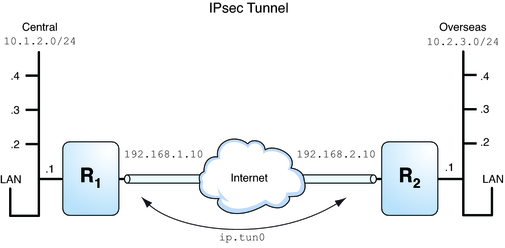| Skip Navigation Links | |
| Exit Print View | |

|
Oracle Solaris Administration: IP Services Oracle Solaris 10 1/13 Information Library |
| Skip Navigation Links | |
| Exit Print View | |

|
Oracle Solaris Administration: IP Services Oracle Solaris 10 1/13 Information Library |
Part I Introducing System Administration: IP Services
1. Oracle Solaris TCP/IP Protocol Suite (Overview)
2. Planning Your TCP/IP Network (Tasks)
3. Introducing IPv6 (Overview)
4. Planning an IPv6 Network (Tasks)
5. Configuring TCP/IP Network Services and IPv4 Addressing (Tasks)
6. Administering Network Interfaces (Tasks)
7. Configuring an IPv6 Network (Tasks)
8. Administering a TCP/IP Network (Tasks)
9. Troubleshooting Network Problems (Tasks)
10. TCP/IP and IPv4 in Depth (Reference)
13. Planning for DHCP Service (Tasks)
14. Configuring the DHCP Service (Tasks)
15. Administering DHCP (Tasks)
16. Configuring and Administering the DHCP Client
17. Troubleshooting DHCP (Reference)
18. DHCP Commands and Files (Reference)
19. IP Security Architecture (Overview)
Protecting Traffic With IPsec (Task Map)
How to Secure Traffic Between Two Systems With IPsec
How to Use IPsec to Protect a Web Server From Nonweb Traffic
How to Generate Random Numbers on an Oracle Solaris System
How to Manually Create IPsec Security Associations
How to Verify That Packets Are Protected With IPsec
How to Configure a Role for Network Security
How to Manage IKE and IPsec Services
Protecting a VPN With IPsec (Task Map)
Description of the Network Topology for the IPsec Tasks to Protect a VPN
How to Protect a VPN With an IPsec Tunnel in Tunnel Mode Using IPv4
How to Protect a VPN With an IPsec Tunnel in Tunnel Mode Using IPv6
How to Protect a VPN With an IPsec Tunnel in Transport Mode Using IPv4
How to Protect a VPN With an IPsec Tunnel in Transport Mode Using IPv6
21. IP Security Architecture (Reference)
22. Internet Key Exchange (Overview)
24. Internet Key Exchange (Reference)
25. IP Filter in Oracle Solaris (Overview)
27. Introducing IPMP (Overview)
28. Administering IPMP (Tasks)
Part VI IP Quality of Service (IPQoS)
29. Introducing IPQoS (Overview)
30. Planning for an IPQoS-Enabled Network (Tasks)
31. Creating the IPQoS Configuration File (Tasks)
32. Starting and Maintaining IPQoS (Tasks)
33. Using Flow Accounting and Statistics Gathering (Tasks)
Oracle Solaris can configure a VPN that is protected by IPsec. Tunnels can be created in tunnel mode or in transport mode. Tunnel mode is interoperable with the implementation of IPsec by other vendors. Transport mode is interoperable with earlier versions of the Solaris OS. For a discussion of tunnel modes, see Transport and Tunnel Modes in IPsec.
IPsec in tunnel mode offers more fine-grained control of the traffic. In tunnel mode, for an inner IP address, you can specify the particular protection you want, down to a single port.
For examples of IPsec policies for tunnels in tunnel mode, see Examples of Protecting a VPN With IPsec by Using Tunnel Mode.
For the procedures that protect VPNs, see Protecting a VPN With IPsec (Task Map).
Figure 20-1 IPsec Tunnel Diagram

The following examples assume that the tunnel is configured for all subnets of the LANs:
## Tunnel configuration ## # Tunnel name is ip.tun0 # Intranet point for the source is 10.1.2.1 # Intranet point for the destination is 10.2.3.1 # Tunnel source is 192.168.1.10 # Tunnel destination is 192.168.2.10
Example 20-6 Creating a Tunnel That All Subnets Can Use
In this example, all traffic from the local LANs of the Central LAN in Figure 20-1 can be tunneled through Router 1 to Router 2, and then delivered to all local LANs of the Overseas LAN. The traffic is encrypted with AES.
## IPsec policy ##
{tunnel ip.tun0 negotiate tunnel}
ipsec {encr_algs aes encr_auth_algs sha1 sa shared}Example 20-7 Creating a Tunnel That Connects Two Subnets Only
In this example, only traffic between subnet 10.1.2.0/24 of the Central LAN and subnet 10.2.3.0/24 of the Overseas LAN is tunneled and encrypted. In the absence of other IPsec policies for Central, if the Central LAN attempts to route any traffic for other LANs over this tunnel, the traffic is dropped at Router 1.
## IPsec policy ##
{tunnel ip.tun0 negotiate tunnel laddr 10.1.2.0/24 raddr 10.2.3.0/24}
ipsec {encr_algs aes encr_auth_algs sha1 shared}Example 20-8 Creating a Tunnel for sendmail Traffic Only Between Two Subnets
In this example, a tunnel is created for sendmail traffic only. The traffic is delivered from subnet 10.1.2.0/24 of the Central LAN to the email server on the 10.2.3.0/24 subnet of the Overseas LAN. The email is encrypted with Blowfish. The policies apply to the remote and local email ports. The rport policy protects email that Central sends to the remote email port of Overseas. The lport policy protects email that Central receives from Overseas on local port 25.
## IPsec policy for email from Central to Overseas ##
{tunnel ip.tun0 negotiate tunnel ulp tcp rport 25
laddr 10.1.2.0/24 raddr 10.2.3.0/24}
ipsec {encr_algs blowfish encr_auth_algs sha1 sa shared}## IPsec policy for email from Overseas to Central ##
{tunnel ip.tun0 negotiate tunnel ulp tcp lport 25
laddr 10.1.2.0/24 raddr 10.2.3.0/24}
ipsec {encr_algs blowfish encr_auth_algs sha1 sa shared}Example 20-9 Creating a Tunnel for FTP Traffic for All Subnets
In this example, IPsec policy protects the FTP ports in Figure 20-1 with AES for all subnets of the Central LAN to all subnets of the Overseas LAN. This configuration works for the active mode of FTP.
## IPsec policy for outbound FTP from Central to Overseas ##
{tunnel ip.tun0 negotiate tunnel ulp tcp rport 21}
ipsec {encr_algs aes encr_auth_algs sha1 sa shared}
{tunnel ip.tun0 negotiate tunnel ulp tcp lport 20}
ipsec {encr_algs aes encr_auth_algs sha1 sa shared}## IPsec policy for inbound FTP from Central to Overseas ##
{tunnel ip.tun0 negotiate tunnel ulp tcp lport 21}
ipsec {encr_algs aes encr_auth_algs sha1 sa shared}
{tunnel ip.tun0 negotiate tunnel ulp tcp rport 20}
ipsec {encr_algs aes encr_auth_algs sha1 sa shared}